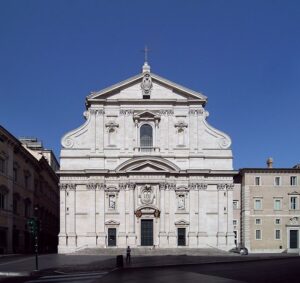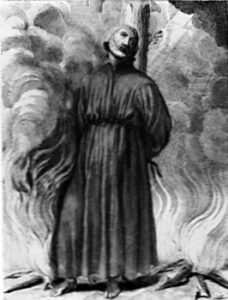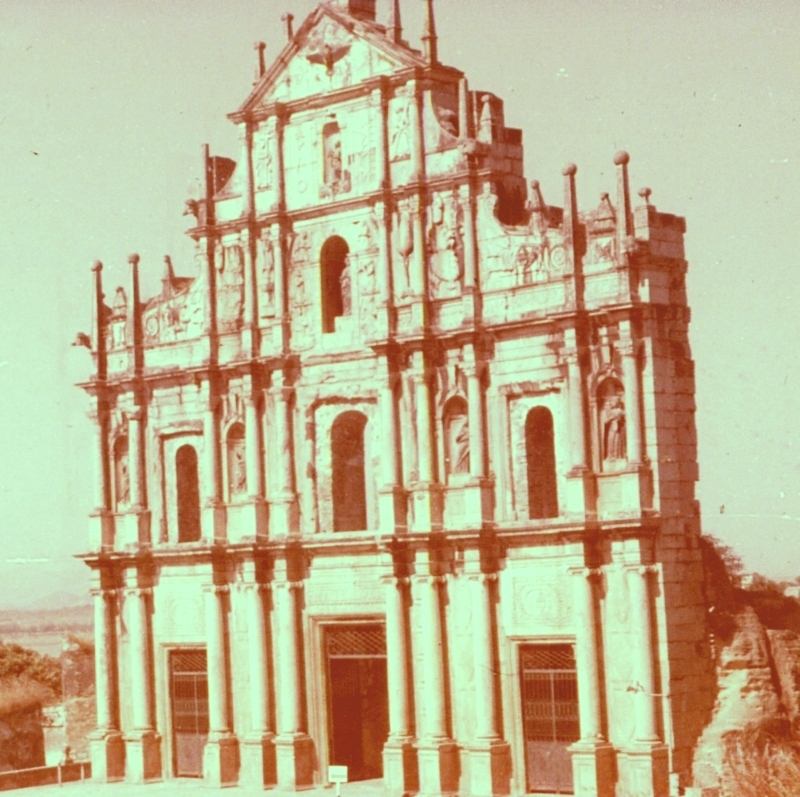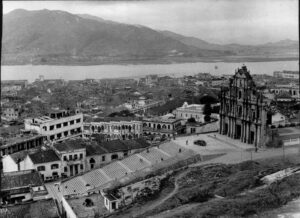SÃO PAULO
by Henry d’Assumpção
| Macau’s most famous landmark is the façade of the Church of the Mother of God (Madre de Deus), which is today commonly called São Paulo (St Paul’s church)1. It is all that is left of what was once the outstanding baroque structure of Eastern Asia. An earlier church was first constructed on the site in 1580, which was burned in 1595 and destroyed by fire in 1601. Reconstruction of a magnificent new church began in 1602, which was not completed until 1644. It was part of an complex including a college – the first in Western Asia – and a large library that was considered the most valuable in South-East Asia. |
Jesuit Report on the Madre de Deus church, 1644
The newly-built church is described in a 1644 report: Alms were given this year to crown the main façade of this Church, which is all of carved stone in a Roman manner. From top to bottom it has three orders of columns with their pedestals, six arched niches in good proportion; four of the ones which are half domes are on the first frieze amongst the orders of the second order of columns, each by itself next to the opening of the three windows of the choir: in them there are the half length figures of our Saints Ignatius, Xavier, Borja and Gonzaga, each one in his niche, over stone bases with their names carved ont them in the same order as we have them on the main altar: all in bronze with their foundry signs: hands and faces painted red; vestments gilded throughout the length of the body, with no other colour. On the second frieze and third storey with columns that rest on the middle window the Image of Our Lady of the Assumption, titular saint of the Church, has its niche, which image steps on a large gilded moon; over her head two Angels in the round of the same metal appear to be holding a closed crown, each of which holds out his arm on the side where he is. Below these another pair seem to go through the air giving a hand in favour of Our Lady’s ascent. The third frieze, which runs underneath the last storey, gave place to the last niche. It has on its base the Image of the infant Jesus with a cross on the globe of the world on his hand and which does not differ from the others in anything, except that it is of lesser height than them. Inside the field of the pointed summit which makes a straight triangle – on which rests the stone pedestal on which is to be fixed the iron cross with rod arms that is the crown of the whole work, for which alms were given this year as I said above – from the middle of rays carved in the stone, a kind of image of a dove goes forth, representing the Holy Spirit with its wings wide open, in gilded bronze and of significant size. Note: for all of this magnificent and sumptuous work expenses were met with alms. Litterae Annua of 1644 for the Japan Province written by António Ferreira, in the archives of the Historical Institute of the Society of Jesus, in Rome, translated by Cesar Guillen-Nuñez
The artisans who worked on the church were Christian Japanese refugees from Nagasaki who had fled from the religious persecution of the Tokugawa regime2 and local Chinese. Its architect was an Italian Jesuit priest, Fr Carlo Spinola (1564-1622). It seems unlikely, as stated in some articles, that he supervised the construction of the church, because he spent most of his time as a missionary in Japan, operating underground to elude persecution for four years, until he was captured and martyred, 22 years before the church was completed 3. More probably the decorations of the façade were done under the supervision of another Italian Jesuit, Giovanni Nicolao from Nola.


At the centre of the third tier is a statue of the Assumption of the Virgin Mary, with a frieze of chrysanthemums (representing China) and peonies (representing Japan), standing on a large (originally gilt) moon (clearly a reference to the Entrance Antiphon of the Feast of the Assumption: ‘A great sign appeared in heaven: a woman, adorned with the sun, standing on the moon …’ Revelation 12:1). She is surrounded by angels with incense and trumpet. On her left are carved bas-reliefs of:
- a beast with tail, short horns, snout, large bat’s wings and breasts, slain by an arrow, with a caption in Chinese “The Devil tempts Mankind to do evil things”.
- a Portuguese ship under the protection of Our Lady and
- a baroque fountain.
On the right are three carvings:
- the Tree of Life (referring presumably to the tree at the centre of the garden of Eden – Genesis 3:3)
- a seven-headed monster with an image of the Virgin Mary above one of its heads and the inscription ‘The woman crushes the dragon’s head’ (Reference: ‘Then a second sign apeared in the sky, a huge red dragon which had seven heads … ‘ Revelation 13:1 and ‘I will put enmity between you and the woman, between your seed and her seed. It will crush your head … ‘ Genesis 3:15)
- a skeleton with inscription ‘Remember death and do not sin’
At the centre of the next tier is a statue of the Child Jesus with a raised right hand and left hand extended (originally holding an cross-topped orb, which is now missing). He is flanked by items from the last few days of the life of Jesus: on the left a whip, crown of thorns, hammer, spears, and on the right a ladder, pliers(?), palms(?) representing his triumphal entry into Jerusalem, nails.
A large dove (originally gilt), representing the Holy Spirit, dominates the top tier. On either side are the sun and moon.
The top two tier include inscriptions in Chinese that are legible from the ground but the calligraphy is of inferior quality.
It is interesting that the bronze statues (and many of the cannons of the fortifications of Macau) were cast in a foundry in the settlement.
At one stage the structure was leaning dangerously and there were calls for the ruins to be demolished but these were fortunately resisted. Archaeological excavations at the site, from 1990 to 1995, uncovered the crypt and foundations that revealed the architectural plans of the building. The ruins were restored by the Government of Macau, with the façade buttressed for protection.
In 2005 the ruins of S. Paulo were listed as part of the UNESCO World Heritage Site Historic Centre of Macau so they will be protected for posterity.
